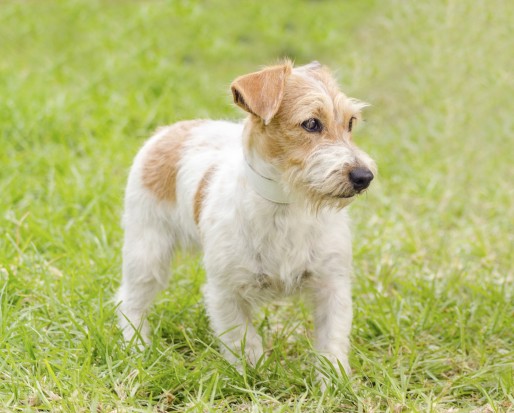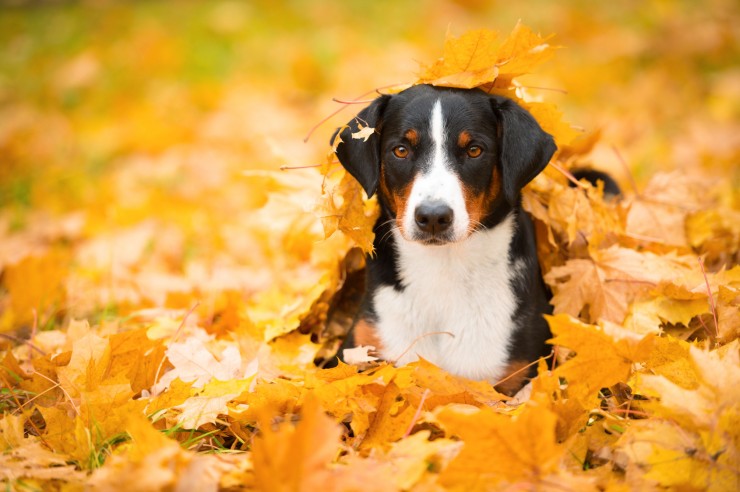Description: The Neapolitan Mastiff is a very strong dog, whose height is 26 to 30 inches in the dog and 24 to 28 inches in the bitch; this breed can weigh up to 165 pounds, with the largest recorded male being just short of 200 pounds. The body is large and stocky with great quantity of skin on the head and large dewlap. The head is flat and fairly wide and looks bigger than the rest of the body. The muzzle is one third the length of the head and is as broad as it is long. With a large nose that has opened nostrils, and the colour matches the coat. The Neapolitan Mastiff teeth can meet in a slight undershot bite, pincer or scissor bite. They have deep set eyes that are almost hidden by the dropping upper lids; the eye colour is either amber or brown depending on the coat colour. The Neapolitan Mastiff ears may be cropped, in countries that do not permit it, these are left natural. The tail is carried straight up and is rounded over the back. With sturdy legs this dog has rounded feet with well arched toes. Their coat is straight, very dense and short furred. The colours that come with this breed are; black, blue, grey tawny and mahogany and very rarely chocolate. A little white is permitted on the chest and toes, but there should never be white on the face. This breed has a short life expectancy of up to 10 years.
History: This breed descends from the Tibetan Mastiff, as do all European mastiffs. It's generally believed to be the earliest member of the canine species. Being seen in Greece, in around 300 BC, and it was brought from India by Alexander the Great. The Greeks went on to introduce the dog to the Romans. Who use these dogs in circus combat. Another thought of how this breed started is that the Phoenicians brought this dog to Britain in 500 BC. The Neapolitan mastiff is a straight descendant of the Roman Molossus. The breed became extinct throughout the rest of Europe and survived only in Campania, this is why it is said that the Neapolitan Mastiff has existed in Campania for 2000 years. This dog has been used in war, and the blood sports, that the Romans were so fond of. This dog has a well-deserved reputation as a guard dog. This dog was first shown in Italy in 1946 and its standards were set in 1949. This is a rare dog to have in America and was recognized by the AKC in 2004.
Temperament: The Neapolitan Mastiff dog is not always as it appears, and is, in fact, very affectionate, calm and loving. They love their family and friends, and with their intelligence love to do their owners bidding. This dog is very protective and courageous, being quiet most of the time and only barking when necessary. It is a good idea to socialise and mix well as a puppy. The Neapolitan Mastiff is usually very kind to children, but really children will need to learn leadership skills. Obedience training is very important for this large dog, and this breed requires a strong willed owner, who understands, and is capable of, controlling this dog properly. With consistency and good training, this dog should do well. Neo's will not listen to a timid person, and these are not dogs for the first time owner. This breed is a heavy droller, particular in hot weather.
The Neapolitan Mastiff breed requires daily walks for mental and physical exercise. If this dog doesn't receive the correct amount of exercise, with a strong and consistent owner, they can become an overprotective and aggressive dog. Good guidance should be found on how best to correct and handle this dog to obtain the best of this breed.
Health issues: The Neapolitan Mastiff dog can have hip dysplasia, bloat, cherry eye and joint pain that will go as the dog gets older.
Grooming: Grooming is easy to do for this dog, using a rubber brush, removing dead hair and debris from a coat is all that is required.
Living conditions: The Neapolitan Mastiff can live in apartments as long as given adequate exercise. They only require a small garden that needs to offer shade on hot days.

 Leptospirosis In Dogs
Leptospirosis In
Leptospirosis In Dogs
Leptospirosis In
 The Differences In Care And Traits Of Rough Versus Smooth Coats On Dogs
The Differences I
The Differences In Care And Traits Of Rough Versus Smooth Coats On Dogs
The Differences I
 Seasonal Hazards In Autumn That Dog Owners Should Watch Out For
Seasonal Hazards
Seasonal Hazards In Autumn That Dog Owners Should Watch Out For
Seasonal Hazards
 When Should I Take My Puppy For Their First Vet Checkup?
When Should I Tak
When Should I Take My Puppy For Their First Vet Checkup?
When Should I Tak
 Dogs are people too!!!
Dogs are people too!!!
A definitive open delib
Dogs are people too!!!
Dogs are people too!!!
A definitive open delib